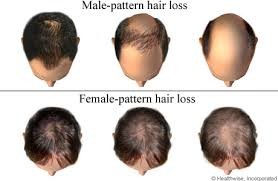Hereditary-Patterned Baldness – What Is It?
Hereditary-pattern baldness is the most common cause of hair loss. Hereditary-pattern baldness is not really a disease, but a natural condition caused by some combination of genetics, hormone levels and the aging process.
Almost all men and women will notice hair loss or hair thinning as they age. However, up to 40% of men and women will experience a more obvious form of this condition. Hair loss typically begins in the 20s and 30s, although in women the changes are most noticeable after menopause. The condition is also called androgenetic alopecia and, in men, male-pattern baldness.
Researchers have begun to understand more about the cause of this type of hair loss. Under the influence of a form of the male hormone testosterone, the normal cycle of hair growth changes, resulting in shorter, thinner or “miniaturized” hair. Eventually, hair growth in certain parts of the scalp stops entirely, which causes the typical pattern of hair loss. Contrary to the folk wisdom that baldness is inherited from one’s mother’s family, the condition seems to depend on genes contributed by both parents.
Symptoms
Hereditary-pattern baldness starts with thinning of the hair and often progresses to complete hair loss on parts of the scalp. Hairs on the pillow, in the tub or on the comb are unreliable symptoms of hair loss. The average non-balding person loses 100 hairs per day, and more hair may fall out under certain circumstances, such as after childbirth or a serious illness.
In men, hair loss typically begins at the temples and crown and proceeds in an M-shaped pattern. In the most advanced stage, only a rim of hair along the side and back of the scalp remains.
In women, hair loss tends to be more widespread but better hidden. The top of the head down the middle is most commonly affected, often in a “Christmas tree” pattern. In contrast to men, the hairline along the forehead and temples usually remains normal in women. Complete loss of hair in any one place on the scalp is unusual and may suggest that a different problem is the cause, such as alopecia areata (an immune system disorder that causes bald patches), a fungus infection or one of a number of other skin conditions.
Diagnosis
Hereditary-pattern baldness usually is diagnosed by both its pattern and a history of a similar type of hair loss affecting family members. In most people, no further tests are required.
When To Call a Professional
Call a health care professional if you have any of the following symptoms; they can suggest a problem other than hereditary-pattern baldness:
- Hair that falls out suddenly or in clumps
- Patchy hair loss (“flea bitten” appearance)
- Redness, flaking or scarring of the scalp in the area of hair loss
- Hair loss in women under age 30
- Signs of abnormally high testosterone levels in women, including abnormal menstrual periods, deepening of the voice, acne, hair loss in a male pattern or hair growth in unusual places (face, chest)
Prognosis
Unless a preventive treatment is started, hereditary hair loss becomes more pronounced over time. Generally, the earlier hair loss begins, the more severe it will become.



Comments are closed.